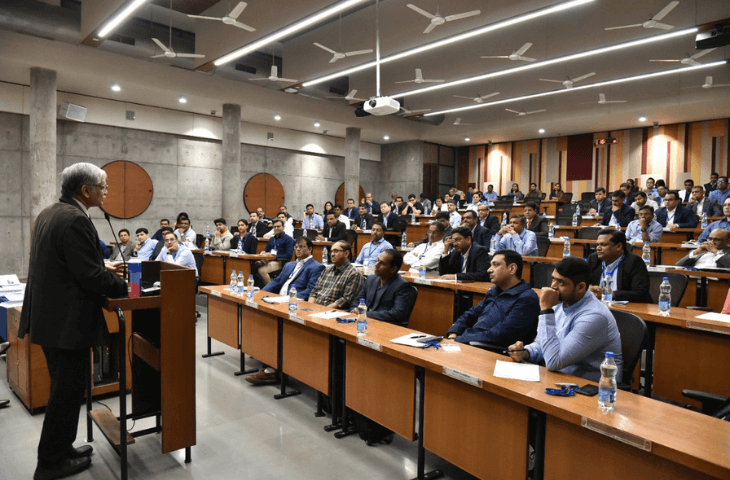CAT Exam VS GMAT Exam
CAT Exam VS GMAT Exam – MBA is a very popular master’s degree that many people want to get. Employers really like it, and students are excited about it. Every year, a lot of ambitious people apply to MBA programs.
There are two big tests that you can take to get into MBA programs: the Common Admission Test (CAT) and the Graduate Management Admission Test (GMAT). These tests are accepted by all the major business schools, including the IIMs. People often wonder which test is easier, GMAT or CAT. This article is here to help you understand the differences between GMAT and CAT in different situations.
CAT Exam VS GMAT Exam – Overview
CAT and GMAT exams are two prominent tests used for admission to MBA programs, with CAT primarily for Indian B-schools and GMAT for international business schools. Understanding their differences and purposes is crucial for aspiring MBA candidates.
| Features | GMAT | CAT |
|---|---|---|
| Exam Full Form | Graduate Management Admission Test | Common Admission Test |
| Conducting body | Graduate Management Admission Council | Indian Institute of Management |
| Validity | Global/for five years | In India and some foreign universities, valid for only one year |
| Eligibility | No minimum percentage required in bachelor’s degree | Bachelor’s degree with minimum of 50% marks |
| Frequency | Anytime of the year | Once a year (November end or December beginning) |
| Mode of Exam | Online | Online |
| Exam Sections | Verbal Reasoning Quantitative Reasoning Integrated Reasoning Analytical Writing Assessment | Quantitative Aptitude Data Interpretation & Logical Reasoning Verbal Ability and Reading Comprehension |
| Number of sections | 4 | 3 |
| Number of questions | 80 Questions | 66 questions |
| Exam Duration | 187 minutes | 120 minutes |
| Sectional time limit | Quantitative Reasoning: 62 minutes Verbal Reasoning: 65 minutes Integrated Reasoning: 30 minutes Analytical Writing Assessment: 30 minutes | 40 minutes for each section |
| Difficulty level | High | High |
| Marking Scheme | 0-6 for Analytical Writing Assessment1-8 for Integrated Reasoning0-60 for Verbal Reasoning and0-60 for Quantitative Reasoning | 3 for correct answer-1 for incorrect answer |
| Exam Fee | USD 250 | General and NC-OBC: INR 2,300SC/ST/PWD (DA): INR 1,150 |
CAT Exam VS GMAT Exam: Eligibility Criteria
One key distinction between CAT and GMAT lies in their eligibility criteria. Let’s explore the eligibility requirements for each of these exams below.
CAT Eligibility Criteria
Here’s the eligibility criteria for CAT presented in a table format:
| Eligibility Criteria | Details |
|---|---|
| Educational Qualification | Candidates must have a bachelor’s degree in any discipline from a recognized university or institute. |
| Minimum Percentage Required | – General and OBC-NC category candidates need a minimum of 50% marks in aggregate or an equivalent CGPA. – Reserved category candidates (SC, ST, PWD) require a minimum of 45% marks. |
| Graduation Duration | The bachelor’s degree program should have a minimum duration of three years. |
| Final Year Students Eligibility | Final year graduation students are eligible to apply for CAT 2024, provided they complete their program within the stipulated schedule. |
| Age Limit | There is no age limit for candidates applying for or appearing in CAT 2024, meaning individuals of all age groups are welcome to take the exam. |
GMAT Eligibility Criteria
Here’s the eligibility criteria for the GMAT exam presented in a table format:
| Eligibility Criteria | Details |
|---|---|
| Discrimination | No discrimination based on religion, sex, background, or education. |
| Age Requirement | – Candidates must be 18 years or older to apply without consent. – If aged 13 to 17, a written proof from a guardian is required. |
| Upper Age Limit | There is no specified upper age limit for GMAT candidates. |
| Educational Qualification | Any candidate with a bachelor’s degree from a recognized institute is eligible. |
| Minimum/Maximum Academic Qualification Limit | There are no minimum or maximum academic qualification limits for GMAT. |
| Number of Attempts | – Candidates can take the GMAT a maximum of five times within 12 months. – There should be a minimum 16-day gap between each re-attempt. – A candidate is not allowed more than eight attempts in a lifetime. |
| Waiting Period for Perfect Score (800) Retake | If you score a perfect 800 on GMAT, you need to wait for five years before retaking the test. |
CAT Exam VS GMAT Exam – Exam Pattern and Syllabus
Now, let’s examine the distinction between the syllabus of GMAT and CAT. We’ll uncover how the syllabus for GMAT differs from that of CAT.
CAT Section wise Exam Pattern:
| Section | Topic | Score Range |
| Verbal Ability & Reading Comprehension | Reading Comprehension, Critical reasoning, Para summary, grammar, Syllogisms, Verbal reasoning, Para jumble Jumbles, Fill in the blanks, Vocabulary | +3 for every correct answer-1 for every incorrect MCQ answer-0 for incorrect non-MCQ answer |
| Data Interpretation & Logical Reasoning | Case lets and Tables, Bar Graph, Venn Diagrams, Calendars, cubes, clocks, Logical Sequences, Blood Relations, Missing information, Games and Tournaments, Routes and Networks, Seating Arrangement | +3 for every correct answer-1 for every incorrect MCQ answer -0 for incorrect non-MCQ answer |
| Quantitative Aptitude | Algebra, Arithmetic, Number System, Geometry, coordinate Geometry, Mensuration, Percentages, Logarithms, Probability, Trigonometry, Surds and Indices, Time Speed Distance, Ratios & Proportions | +3 for every correct answer-1 for every incorrect MCQ answer -0 for incorrect non-MCQ answer |
GMAT Section wise Exam Pattern:
| Section | Topic | Score Range |
| Analytical Writing Assessment | Analysis of an Argument, Issue Essay | 0-6 (in 0.5-point increments) |
| Integrated Reasoning | Graphics Interpretation, Table Analysis, Multi-source Reasoning, Two-part Analysis | 1-8 (in 1-point increments) |
| Quantitative Reasoning | Data Sufficiency, Problem Solving | 6-51 (in 1-point increments) |
| Verbal Reasoning | Reading Comprehension (60%) Critical Reasoning (20%), Sentence Correction (20%) | 6-51 (in 1-point increments) |
CAT Exam VS GMAT Exam – Sections, Number and Type of Question
The main differences between GMAT and CAT are in the way their question papers are structured. This includes variations in the sections, time limits, and the types of questions they contain. Let’s delve into these distinctions.
CAT
Certainly, here’s the breakdown of the CAT exam details:
- Section Time Limits:
In CAT, each section has a specific time limit within which candidates need to answer the questions. The duration varies for different sections. - Order of Attempt:
Candidates have the flexibility to choose from three different combinations of sections’ order in which they want to attempt the CAT exam. This means they can decide the sequence that suits them best. - Scoring System:
CAT employs a scoring system where candidates earn 3 marks for every correct answer. However, there’s a penalty for incorrect answers. For each wrong answer, candidates lose 1/3 of a mark due to negative marking. This encourages careful answering and penalizes random guessing.
| Sections of Exam (in that order) | No. of questions | Time Limit | Multiple Choice Questions | TITA (Type in the answer questions) |
| Verbal Ability and Reading Comprehension | 26 | 40 minutes | 18 | 8 |
| Data Interpretation & Logical Reasoning | 24 | 40 minutes | 18 | 6 |
| Quantitative Aptitude | 26 | 40 minutes | 18 | 8 |
| Total | 76 | 120 minutes | 54 | 22 |
GMAT
Certainly, let’s break down the details of the GMAT exam:
- Section Time Limits: Each section of the GMAT exam has a specific time limit allocated to it. The duration varies depending on the particular section.
- Order of Attempt: Candidates have the freedom to choose from three different combinations of sections’ order in which they prefer to take the GMAT exam. This allows them to select the sequence that suits them best.
- Computer Adaptive Sections: The sections for Integrated Reasoning and Verbal Reasoning in the GMAT are computer adaptive. This means that once a question is answered, it cannot be skipped, and you cannot go back to a previous page or change your answers.
- Question Formats:
- Quantitative Reasoning and Verbal Reasoning sections consist of multiple-choice questions (MCQs).
- Analytical Writing Assessment includes an essay question.
- Integrated Reasoning section contains non-multiple-choice questions (non-MCQs).
- Negative Marking: Unlike CAT, there is no negative marking in the GMAT exam. This means that candidates do not lose points for incorrect answers, which is different from some other exams and encourages a different approach to answering questions.
| Section | Number of Questions | Time Limit | Question Types |
| Analytical Writing Assessment | 1 question | 30 Minutes | Analysis of an Argument and Issue Essay |
| Integrated Reasoning | 12 questions | 30 minutes | Non- MCQ |
| Quantitative Reasoning | 31 questions | 62 minutes | MCQ |
| Verbal Reasoning | 36 questions | 65 minutes | MCQ |
| Total | 80 | 187 minutes | – |
CAT Exam VS GMAT Exam – Difficulty Level
The steps given below highlights the key differences between CAT and GMAT, considering their patterns, costs, and difficulty levels across various sections.
- Purpose and Popularity:
CAT is a widely taken exam in India for MBA admissions within the country. On the other hand, GMAT is commonly used for MBA admissions globally, especially for international business schools. - Similar Sections and Syllabus:
Both CAT and GMAT have sections that are somewhat similar in terms of content, such as quantitative and verbal skills. - Differences in Pattern, Cost, and Difficulty:
- Pattern: The structure of the two exams differs. GMAT has a more standardized format, while CAT’s format may vary slightly from year to year.
- Cost: The cost of taking GMAT is usually higher compared to CAT.
- Difficulty Levels: GMAT is generally considered to be less challenging than CAT for several reasons:
- Syllabus: CAT’s syllabus is less clearly defined, making GMAT preparation more straightforward.
- Logical Reasoning & Data Interpretation (LRDI) vs. Integrated Reasoning (IR): CAT’s LRDI section has been notoriously difficult, while GMAT’s IR section is simpler in terms of logic.
- Quantitative Ability (QA) vs. Quantitative Reasoning (QR): CAT’s QA section is trickier as it tests not just concepts but also their application, whereas GMAT’s QR section has more straightforward questions.
- Verbal Reasoning: GMAT’s Verbal Reasoning can be challenging for Indian test takers due to its high vocabulary requirements and grammar assessment, unlike CAT.
CAT Exam VS GMAT Exam – Exam Fees
When it comes to the fees for GMAT and CAT, there are some differences. CAT charges 2,000 INR for the General Category and 1,000 INR for SC, ST, and PWD Categories. Importantly, for CAT, once you’ve registered, there are no extra costs because you can’t change your exam date, session, or location, and there’s no option for cancellation or refunds.
On the other hand, GMAT fees vary depending on where you take the test:
- In India, it’s 250 USD.
- In the USA, it’s 275 USD.
- In other European countries, it’s 285 USD.
Additionally, for GMAT, there might be some extra costs, which can vary, and you should check them separately.
| GMAT Exam Fees | Cost (in USD) |
| Application | 260.00 (via Phone) |
| Rescheduling | More than 60 days before appointment: 5015-60 days before appointment: 10014 days and less before appointment: 150 |
| Cancelling | More than 60 days before appointment: 10015-60 days before appointment: 7514 days and less before appointment: 50 |
| Score Reinstatement | 50 |
| AWA Rescoring | 45 |
| Cancel Score (online after you leave the test centre) | 25 |
| Additional Score Reports | 35 each |
CAT Exam VS GMAT Exam – Expected Salary
| Difference | GMAT | CAT |
| Average Tuition Fees | INR 40-65 Lakhs | INR 12 Lakhs |
| Average Salary | INR 65 Lakh Per Annum | INR 15 Lakh Per Annum |
CAT Exam VS GMAT Exam – Key Points
CAT Exam Key Points
Certainly, let’s break down the advantages of CAT in a detailed manner:
- Accepted by Most MBA Programs in India:
- CAT is widely accepted by the majority of MBA programs in India, including prestigious institutions like the Indian Institutes of Management (IIMs) and other renowned business schools.
- Low Investment Required:
- Compared to some other entrance exams, the cost of preparing for and taking the CAT exam is relatively lower, making it more accessible to a wider range of aspirants.
- IIM Syllabus Suited for Indian Business and Management Skills:
- Since CAT is conducted by IIMs, the syllabus is well-tailored to improve skills that are highly relevant to the field of business and management in India. This means it focuses on the specific knowledge and competencies needed in the Indian business landscape.
GMAT Exam Key Points
- Better Return on Investment (ROI):
- GMAT can offer a better return on investment for candidates, as it opens doors to a wide range of prestigious international MBA programs. Graduating from these programs can lead to higher earning potential and career growth, potentially justifying the investment in the exam.
- Better Opportunities Abroad:
- GMAT scores are widely accepted by business schools around the world, providing candidates with better opportunities to pursue MBA or other business-related degrees abroad. This global acceptance enhances the chances of gaining exposure to diverse cultures and expanding one’s professional network internationally.
- Multiple Test Dates in a Year:
- GMAT allows candidates the flexibility to take the exam multiple times within a year, enabling them to improve their scores and enhance their chances of securing admission to their desired business schools.
- Scores Valid for 5 Years:
- GMAT scores remain valid for five years, offering candidates the flexibility to apply to business schools at their preferred time without worrying about the expiration of their test scores. This extended validity allows for strategic planning and timing of MBA applications.
CAT Exam VS GMAT Exam – Frequently Asked Question
Q1: How does the cost of CAT compare to GMAT, and which is more affordable for Indian students?
Ans: CAT is generally more cost-effective for Indian candidates, with lower registration fees and no need for international travel, making it a budget-friendly option.
Q2: Can CAT provide a deeper understanding of Indian business dynamics compared to GMAT?
Ans: Yes, CAT’s curriculum focuses on Indian business practices and management, ensuring that candidates are well-prepared to navigate the nuances of the Indian corporate landscape.






